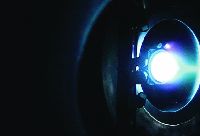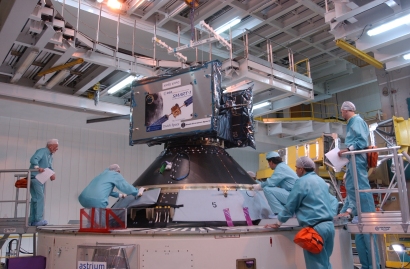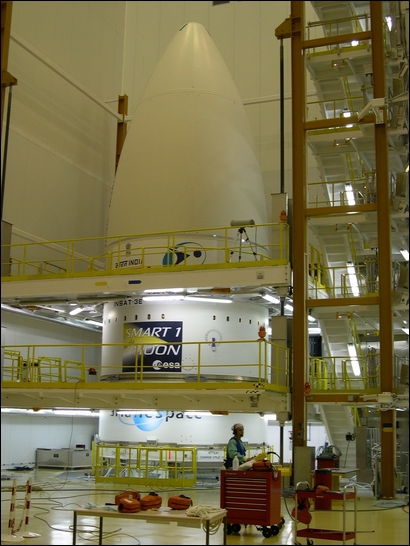| View previous topic :: View next topic |
| Author |
Message |
MIKE BURN
Generally Crazy Guy

Joined: 08 Nov 2001
Posts: 4825
Location: Frankfurt / Europe
|
 Posted: Sun Sep 28, 2003 11:40 am Post subject: Travelling through space propelled by ionic beams Posted: Sun Sep 28, 2003 11:40 am Post subject: Travelling through space propelled by ionic beams |
 |
|
Ion Drive
No fireworks but an eerie blue glow
SMART-1 is to be the first European spacecraft to travel to and orbit around the Moon. It will also be the first time that ESA employ electric propulsion as the mission's primary propulsion. Electric propulsion on an interplanetary mission has been used only once to date, on NASA's Deep Space 1 probe launched in October 1998.
Travelling through space propelled by ionic beams may sound like 'Star Wars' science fiction, but the technology is very much a reality - and it is the key to future space missions, scientific and commercial, that would otherwise be impractical or too expensive.

(Testing SMART-1's Ion Drive)
The electric propulsion technology to be employed by SMART-1 was initially developed over 30 years ago, notably in Russia which, since 1972, has launched a number of operational spacecraft placed in Earth orbit. They used electric propulsion for attitude and orbit control in addition to the classical chemical propulsion. In the early 90s, agreements were reached between Russian, American and European industry, notably SNECMA, France, to pursue the development and commercialisation of such thrusters. The advantages of such propulsion will soon be demonstrated by European industry on the CNES 'Stentor' telecommunications and technology satellite.
Electric propulsion thrusters use electrical power provided by the spacecraft's solar panels to accelerate a propellant to high velocity creating a reaction which causes the movement of the spacecraft. The use of electrical power enhances the performance of a thruster with respect to conventional chemical thrusters. Electric propulsion thrusters are generally classified as electrothermal, electrostatic, or electromagnetic, depending on the principle by which the propellant is accelerated.
The SMART-1 mission employs an electrostatic system and more precisely a Hall-effect thruster, the PPS-1350 provided and qualified by SNECMA. The propellant used is xenon, the same colourless gas that fills advanced car lightbulbs and that is used in some medical applications.
The PPS-1350 is a very compact device built around an annular ceramic chamber 10 cm in diameter ringed with magnets. Attached to one side is a device called a cathode which creates electrons. The electrons are attracted into the chamber by another device called an anode. Trapped inside the chamber by a magnetic field, the electrons collide with the incoming xenon gas and form Xenon ions, positively charged particles and more electrons. These electrons are then used again to accelerate the ions, which rush out of the chamber accelerated by the electric field created by the electrons from the cathode. It is this ion beam, with a characteristic blue colour because of the xenon, that creates the thrust to push the spacecraft forwards.
The specific impulse (ISP) of a thruster is the impulse (a force applied for a certain time) exerted with 1 kg of propellant. Therefore the units for Specific Impulse are Newton-seconds per kilogram (Nskg-1). It follows that the higher the specific impulse, the greater the performance of the engine and the less propellant required. The numerical value of the Specific Impulse also corresponds to the effective exhaust velocity (in metres per second) of the gas exiting the thruster in a vacuum.
Classical chemical thrusters have a low specific impulse (in the order of 3000 Nskg-1, with gases ejected at 3000 ms-1) which entails the need for considerable quantities of propellant. Electric thrusters eject their particles at very high speed (15 - 100 kms-1). Their specific impulse of 15 000 to 100 000 Nskg-1 can be 5 to 30 times greater than a conventional thruster.
The thrust produced by the SMART-1 electric propulsion engine is barely perceptible. It is the equivalent to the pressure exerted by a sheet of paper held in the palm of a hand. But functioning for long periods, an electric propulsion system can ultimately provide a much higher velocity increment to the spacecraft.
The thrust produced by an electric thruster can easily be modulated and adjusted within a certain range. This can satisfy specific needs during a mission or adapt to the electrical power available on board at any time during the operational life of a spacecraft.
Interplanetary missions can also save time. Even though the thrust is low, an electric thruster can fire for extremely long periods, with the result that a spacecraft may reach its target quicker than if chemical propulsion had been employed.
Missions using electric propulsion offer greater flexibility in space navigation, more opportunities for planetary gravity-assisted fly-bys, wider launch windows and less powerful launchers. Whether it be on a journey today to the Moon or tomorrow towards Mercury, such space science missions can be smaller, faster, more cost effective. In one word, SMARTER!

(SMART-1 resting on top of the upper stage of the Ariane 5 launcher in the final assembly building)

(Date: 24 Sep 2003
Depicts: Ariane 5 launch fairing
Location: Kourou Spaceport
SMART-1 logo on Ariane 5 launcher fairing )
MIKE

|
|
| Back to top |
|
 |
droolymutt
No Underblurb
Joined: 25 Jul 2002
Posts: 6721
Location: Montreal, Canada
|
|
| Back to top |
|
 |
bbchris
Princess Of Hongkong
Joined: 01 Jan 2002
Posts: 11441
Location: Hong Kong
|
|
| Back to top |
|
 |
droolymutt
No Underblurb
Joined: 25 Jul 2002
Posts: 6721
Location: Montreal, Canada
|
 Posted: Sun Sep 28, 2003 2:07 pm Post subject: Re: Travelling through space propelled by ionic beams Posted: Sun Sep 28, 2003 2:07 pm Post subject: Re: Travelling through space propelled by ionic beams |
 |
|
Depends.
Do you need orbit control?
|
|
| Back to top |
|
 |
bbchris
Princess Of Hongkong
Joined: 01 Jan 2002
Posts: 11441
Location: Hong Kong
|
|
| Back to top |
|
 |
Netjams
Joined: 27 Dec 2001
Posts: 2307
|
|
| Back to top |
|
 |
droolymutt
No Underblurb
Joined: 25 Jul 2002
Posts: 6721
Location: Montreal, Canada
|
|
| Back to top |
|
 |
bbchris
Princess Of Hongkong
Joined: 01 Jan 2002
Posts: 11441
Location: Hong Kong
|
|
| Back to top |
|
 |
markhewer

Joined: 04 Jan 2003
Posts: 246
|
|
| Back to top |
|
 |
|









 - who does it remind you of?
- who does it remind you of?





 You're freaking me out with these space postings!!! I love it!!!!!
You're freaking me out with these space postings!!! I love it!!!!!

